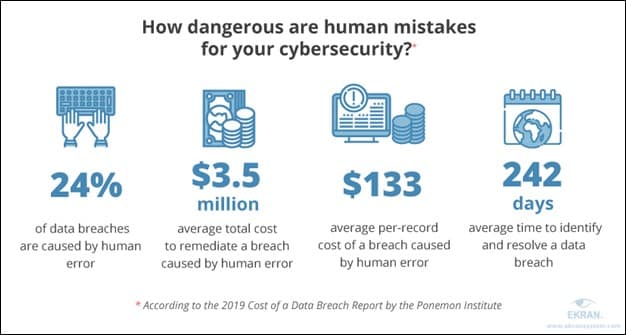With a rise in the number of cyber-attacks, organizations put in efforts to implement cybersecurity policies, defenses, and processes. However, a state-of-the-art security system will be useless if it is not backed by cybersecurity awareness, education, and training among the ‘Organization’s First Line Of Defence,’ i.e., employees.
As sophisticated digital threats show a steeply increasing trend, there is a need to educate an organization’s digital workforce on cybersecurity best practices. According to Statista Research Department Report, US organizations spend billions to implement top-notch cybersecurity systems. However, despite so much security, adversaries break through security systems due to the presence of human error. As per the BAE Systems 2019 report, around 71% of phishing and 65% of virus/ malware attacks happen due to such errors.
A tiny error caused inadvertently by an employee can put the confidentiality, integrity, and availability of an organization’s critical data resources at stake. It could bring as a consequence vast losses of finance and reputation. Therefore, it has become essential to educate human resources in any enterprise by conducting security awareness training programs and taking cybersecurity awareness seriously.

(Image Source: Pixabay.com)
Cybersecurity Awareness Training For Your Staff
In 2021, one needs to accept that cyber threats can go beyond just financial losses, affecting the brand’s image to the extent that its existence could be wiped out. Cybersecurity awareness must be a priority for every organization. By conducting cybersecurity awareness training for employees, an organization reduces its exposure to various cyber threats due to human errors. The training helps the employees and the management understand the current and potential information security concerns. It also educates the employees on corporate policies and procedures to work in line with the information technology structure. The main aim of cybersecurity education is to:
- Understand IT governance issues
- Recognize various security concerns
- Know how to identify and mitigate a threat
- Learn the relevance of responding accordingly
Through cybersecurity training courses, employees get trained to protect the information flow and uphold information that is a valuable organizational asset. One can also go through NIST’s (National Institute Of Standards and Technology) guidelines on the security awareness training program for formulating a proper training structure.

(Source: ekransystem.com)
Purpose Behind Cybersecurity Awareness Training
Cybersecurity awareness training programs are conducted to educate the employees on the following aspects of cybersecurity:
- How to protect their information systems as well as personal information from malicious actors and data loss or corruption due to inappropriate use and management of data
- How to stay secure at all times from the adversaries scouring the web to find potential targets
- How to develop essential competencies for cybersecurity considering it as a pressing need of time
- How to handle cybersecurity threats and issues by learning new techniques and methods
Essential Topics To Cover In Cybersecurity Awareness, Education, And Training In 2021
Considering the rise in sophisticated strategies and advanced tactics employed by malicious actors these days, here is a list of the most essential cybersecurity awareness training topics relevant for 2021.
- Phishing Attacks
Last year, every organization’s operations were affected by the COVID-19 pandemic, and the world witnessed a massive increase in pandemic-related phishing attacks at the time. In mid-April, Google’s Threat Analysis Group reported that they had detected and blocked around 18 million COVID-19 themed phishing attempts as well as malware emails each day.
Even after years, phishing attacks are still one of the significant causes of security breaches. As per the Enterprise Phishing Susceptibility Report of PhishMe, 91% of the cyber attacks occur due to phishing scams. Phishing and spear-phishing threats are still growing in 2021, even though organizations are well aware of such threats. A reason behind this issue is the lack of awareness at the level of employees. An organization can drastically reduce the number of phishing attacks by adding cybersecurity education and training to its philosophy.
- Public Wi-Fi
One should know that employees often use public Wi-Fi while traveling or working on the move. In such a case, it becomes essential that extra training be imparted to the human workforce regarding the safe use of Wi-Fi services. Malicious actors can use fake public Wi-Fi networks, rendering the unsuspecting end-user vulnerable and making them upload sensitive data to un-secure public servers.
Hence, there is a need to educate employees regarding public Wi-Fi safety measures and detecting common signs of a potential scam.
- Security Of Mobile Devices
As on-the-go work using mobile devices make the work environment more flexible, there has been an increased need for device protection. Users currently experience increased connectivity and accomplish essential tasks using mobile devices. However, the remote work style has made user-device accountability a vital aspect of cybersecurity training in 2021.
Malicious mobile apps are one of the significant causes of a security breach in mobile devices. Hence, it has become necessary to educate employees on the best practices to be followed while working on mobile devices. They must learn the importance of using encrypted services and password protection to stay secure from unwelcome malicious intrusions.
- Password Security And Authentication
Password security is often not taken seriously, but it is a significant aspect of data security. Malicious actors can easily decrypt a simple password, which gives them quick access to an account. Negligence on the part of employees in setting passwords can prove to be fatal for the organization. A recognizable password pattern can put sensitive data at risk, and once stolen, it can be made available in the public domain or sold on the dark web.
Generally, most organizations prompt the users to create passwords hard to guess, such as ones containing alphabetic letters, numerals, and various special characters. That is because malicious actors don’t guess passwords by manual trial-and-error methods anymore; instead, they use sophisticated computer programs and algorithms to break the password.
Reflecting upon the fact that computers can guess and try millions of options in a short time must drive home the reality. An organization’s human resources can learn about creating randomized and unique passwords by adding password security topics to the cybersecurity training. Putting an extra security layer is also possible by employing two-factor authentication and other defense techniques.
- Cloud Security
Organizations nowadays are evolving and have revolutionized the system of storing and accessing data using cloud computing technology. Through this practice, the organization’s large amount of data is stored remotely by cloud service providers, which makes networking and other tasks more accessible as well. It is a cost-effective option for the organization. However, with a vast amount of private data stored at a remote place, there is an increased risk of large scale data compromise. Cloud storage can become much safer by selecting the right cloud service provider that employs the right data security measures.
However, in 2021 and in the years to come, the primary threat to large scale cloud organizations is insider-induced attacks. As per Gartner, in the coming year, the reason behind a majority of the cloud security incidents will be the user’s negligence. Hence, cloud security training can help and guide the employees in using cloud-based applications more securely.
- Using Social Media Securely
Social media is entwined with people’s lives. Most people are in the habit of sharing their daily lives on social media, from holidays to various events and even work. But, over-sharing can prove to be fatal. Sharing too much personal information on social media can make it convenient for malicious actors to pose as a legitimate source and deceive the user.
Hence, educating employees regarding privacy settings on social media accounts and other security measures can significantly help. It will protect an organization’s sensitive information from coming out in the public domain and prevent the adversaries from using such information as potential leverage to deceive the end-user.
- Internet And Email Security Awareness
Most employees are in the habit of using the same emails for multiple accounts. Around 91% of the people already know that password recycling can pose a severe security threat, yet 51% of them still use the same password for multiple accounts. It means, if one account gets compromised, the malicious actor will have access to all user data, putting all of the private information at risk. Reputed sites online give an option to sign in using one’s email credentials without registering on the site. However, one must be utterly conscious not to follow this practice if it is a less-known site. It could be a phishing attempt looking to steal the user’s email password.
In addition to this issue, one usually gets pop-ups about free software while working on the internet. ‘Free software’ offers try to deceive the user as such software is often infected with malware. Installing software from a reputed source is a way to prevent such a malware attack. Hence, training the employees for safe internet usage habits and following best email practices must form an essential part of IT induction.
- Social Engineering Threats
Malicious actors try to get into the system of the user by using social engineering techniques. Through this method, the adversary attempts to impersonate a reliable source and lure the user into providing access to valuable personal information. Organizations should educate the employee on the most common social engineering techniques and make them acquainted with how attackers influence them.
Generally, cyber-attackers use social engineering techniques like phishing, baiting, pretexting, tailgating, etc., and create a sense of urgency, scarcity, and reciprocity to influence the users. For instance, posing as a bank official, the adversary can ask for immediate sharing of personal information by creating a sense of urgency like account freezing or credit or debit card blocking. Increasing the awareness of employees concerning such impersonation can reduce the risk of social engineering attacks.
- Security Measures To Take At Home
The COVID-19 pandemic made organizations take drastic steps towards promoting work-from-home culture for employees. And remote work concept has become a reality now. By adopting remote work, organizations empower their employees and facilitate an outstanding work-life balance.
However, this trend that has become the new normal has posed some significant concerns relating to security breaches and uncertain intrusions. Hence, a cybersecurity training program should include remote work safety procedures too. Employees’ devices for work should be anti-virus protected, and the organization must take the necessary security steps to safeguard other such devices. Hence, to adapt to the work-from-home lifestyle with utmost security, organizations need to include safe and secure remote work concepts in their cybersecurity awareness training.
Employees must keep in mind that cyber threat does not stop when they leave the workplace; it will continue even if they are at home. It is because organizations now give employees the liberty to work using their devices. It is right that such a remote work culture makes work flexible and saves some cost, but there are risks associated with it, which must extensively be covered in any comprehensive cybersecurity training module.
Final Words
With the current upward trend of cybersecurity threats and attacks, organizations are putting in more efforts to make cybersecurity awareness, education, and training an integral part of their structure. Every organization has a different requirement. Hence, it can opt for a flexible cybersecurity awareness training program that fits its objectives and goals. Educating the employees through cybersecurity training programs and courses can promote the culture of cybersecurity awareness in an organization perpetually. It will help keep the employees up to date on the security of business and personal data.

